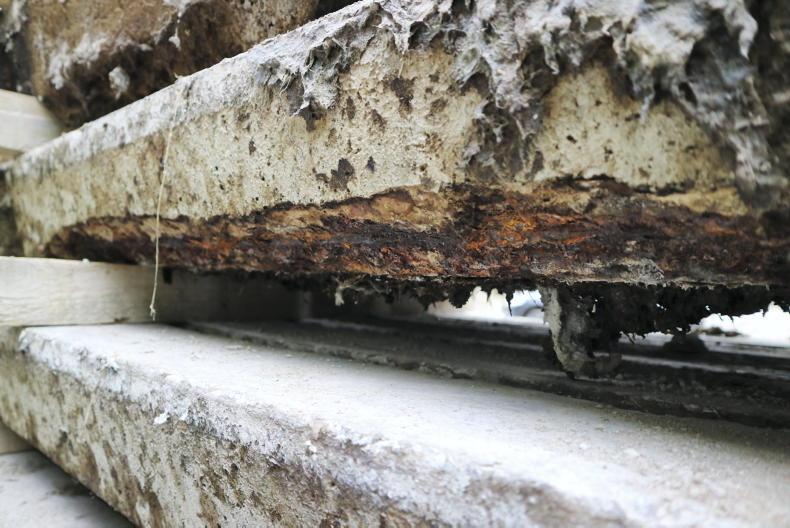Cattle slats have a working life of about 25 years. Despite them being made of reinforced concrete, the loads exerted on slats will eventually cause cracks and weak points to appear.
Where the reinforcing steel is exposed to moisture and air, either at the ends of the slats or through cracking, rust can occur which will lead to the expansion of the steel and cracking of the concrete surrounding it.
TAMS III will cover slat replacement in existing sheds, with either slotted or solid slabs. Solid slabs can be fitted under the TAMS Organic Farming Capital Investment Scheme (OFCIS) at a grant rate of 60%, while calf, sheep or cattle slats can be replaced with new slotted slats for the appropriate animal type under the Farm Safety Capital Investment Scheme (FSCIS), also at a grant rate of 60%.
Grant aid will not be given in buildings where there are internal agitation points or those that share an airspace with buildings with internal agitation points.
The extension of tanks to create external agitation points is eligible for grant aid, as is the installation of simple aeration systems.
Slat replacement shall only be undertaken on tanks that were constructed in accordance with S.123. This means that the replacement of slats will not be grant-aided on slurry/effluent tanks built with concrete blocks with a depth greater than 1.2m.
It is strongly recommended that the tank is fully emptied before any work starts on the replacement of slats.
It is also recommended that no one enters the tank during slat replacement activity.
If, for some reason, it becomes necessary to enter the tank, then the tank should be tested for the presence of any harmful gases prior to anyone entering.
The test should include testing for hydrogen sulphide, methane, ammonia and carbon dioxide.
If there is any doubt as to the levels of gases present, full breathing apparatus shall be used by anyone entering the tank. Gas testing and breathing apparatus shall only be used by trained, competent personnel.
Specifications
Concrete slats shall be produced in accordance with IS EN 12737, and shall be CE-marked and produced in a plant certified by a notified body (eg NSAI or equivalent), to produce slats to IS EN 12737.
Only concrete slats listed on the “Accepted Slat List’’ should be used. A “Certificate of slat manufacture” from a supplier approved by the Department shall be submitted.
Concrete slates should be:
Be free from any cracks, honeycombing and chipping of the top corner arises.Have a full bearing of at least 150mm at points of support for cattle slats and 100mm for pig slats (as per Figure 1).Finished slat floor shall be level and free from any rocking movement.Be capable of being replaced with minimum disturbance. Slats are components with a limited working life and are unlikely to last as long as the building.How do I know when my
slats need to be replaced?
As mentioned, slats have an average lifespan of 25 years, although this will depend on the strain placed on them during their working life and the quality of materials used in manufacturing them.
To assess whether slats require replacement, remove any dung or mats covering the concrete surface and thoroughly clean the slat through power-hosing. Inspect the upper surface of the slat for and cracks or signs of weakness.
The underside of the slat should also be checked, using either an inspection kit or through entering the empty tank, for any cracks or breaking away of the concrete.
Inspection kits consist of a mirror on a handle, with a light attached, that allows viewing of the underside without entering the tank. Some slat manufacturers will provide an inspection service, so it could be worthwhile to contact your approved supplier.
Cattle slats have a working life of about 25 years. Despite them being made of reinforced concrete, the loads exerted on slats will eventually cause cracks and weak points to appear.
Where the reinforcing steel is exposed to moisture and air, either at the ends of the slats or through cracking, rust can occur which will lead to the expansion of the steel and cracking of the concrete surrounding it.
TAMS III will cover slat replacement in existing sheds, with either slotted or solid slabs. Solid slabs can be fitted under the TAMS Organic Farming Capital Investment Scheme (OFCIS) at a grant rate of 60%, while calf, sheep or cattle slats can be replaced with new slotted slats for the appropriate animal type under the Farm Safety Capital Investment Scheme (FSCIS), also at a grant rate of 60%.
Grant aid will not be given in buildings where there are internal agitation points or those that share an airspace with buildings with internal agitation points.
The extension of tanks to create external agitation points is eligible for grant aid, as is the installation of simple aeration systems.
Slat replacement shall only be undertaken on tanks that were constructed in accordance with S.123. This means that the replacement of slats will not be grant-aided on slurry/effluent tanks built with concrete blocks with a depth greater than 1.2m.
It is strongly recommended that the tank is fully emptied before any work starts on the replacement of slats.
It is also recommended that no one enters the tank during slat replacement activity.
If, for some reason, it becomes necessary to enter the tank, then the tank should be tested for the presence of any harmful gases prior to anyone entering.
The test should include testing for hydrogen sulphide, methane, ammonia and carbon dioxide.
If there is any doubt as to the levels of gases present, full breathing apparatus shall be used by anyone entering the tank. Gas testing and breathing apparatus shall only be used by trained, competent personnel.
Specifications
Concrete slats shall be produced in accordance with IS EN 12737, and shall be CE-marked and produced in a plant certified by a notified body (eg NSAI or equivalent), to produce slats to IS EN 12737.
Only concrete slats listed on the “Accepted Slat List’’ should be used. A “Certificate of slat manufacture” from a supplier approved by the Department shall be submitted.
Concrete slates should be:
Be free from any cracks, honeycombing and chipping of the top corner arises.Have a full bearing of at least 150mm at points of support for cattle slats and 100mm for pig slats (as per Figure 1).Finished slat floor shall be level and free from any rocking movement.Be capable of being replaced with minimum disturbance. Slats are components with a limited working life and are unlikely to last as long as the building.How do I know when my
slats need to be replaced?
As mentioned, slats have an average lifespan of 25 years, although this will depend on the strain placed on them during their working life and the quality of materials used in manufacturing them.
To assess whether slats require replacement, remove any dung or mats covering the concrete surface and thoroughly clean the slat through power-hosing. Inspect the upper surface of the slat for and cracks or signs of weakness.
The underside of the slat should also be checked, using either an inspection kit or through entering the empty tank, for any cracks or breaking away of the concrete.
Inspection kits consist of a mirror on a handle, with a light attached, that allows viewing of the underside without entering the tank. Some slat manufacturers will provide an inspection service, so it could be worthwhile to contact your approved supplier.






 This is a subscriber-only article
This is a subscriber-only article









SHARING OPTIONS: